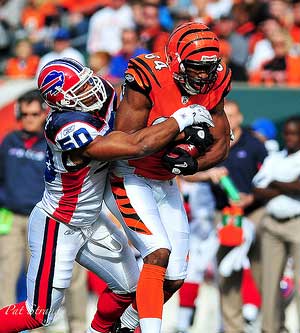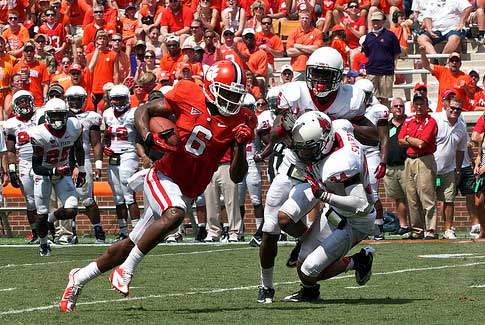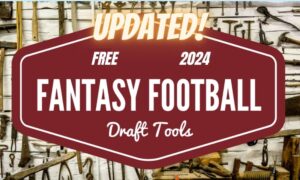In the NFL, talk is cheap, and actions speak louder than words. More so than comments by front office members, coaches, and team officials, the NFL Draft gives a true indication of what a team thinks of veteran players currently on their roster. This is a two-part article that will look at last week’s draft and what NFL veteran players will see the largest negative impact from it.
To determine which veteran players will see the biggest drop in Fantasy production, we will look at three variables: The talent of the player drafted, the talent of the veteran player who will compete with the drafted player, and the position these guys play.
The Role of Talent
The talent level of a newly drafted player and a veteran currently on a team’s roster play a crucial role when you look at how a veteran player will be impacted by the addition of a rookie draft pick. For example, DeAndre Hopkins (talented) was the second wide receiver drafted by the Texans, while Andre Johnson (very talented) is the veteran wide receiver that would have the most to lose when it comes to the addition of another wide receiver. But, because of Johnson’s talent level, there is no reason for concern when it comes to his Fantasy outlook for this year.

Jermaine Gresham is at a crossroads in his career. He might not be hurt by rookie TE Tyler Eifert’s presence this season, but he has to do more in 2013. Photo Credit: Pat Strang
Then I took these players and compared them with their competition on their new team. NFL players that face the most competition (the least talented veterans) from newly acquired rookies (the most talented draft picks) are the players that have to most to lose, and the players that made this preliminary list.
This list is a position-by-position breakdown of players that will face the most competition from rookie players. But, in no way are these position battles ranked in a meaningful way. That will come later.
Rookies vs. Veteran Players
Quarterbacks
Bills – E.J. Manuel vs. Kevin Kolb
Jets – Geno Smith vs. Mark Sanchez
Eagles – Matt Barkley vs. Michael Vick/Nick Foles
Raiders – Tyler Wilson vs. Matt Flynn/Terrelle Pryor
Running Backs
Bengals – Giovani Bernard vs. Benjarvus Green-Ellis
Steelers – Le’veon Bell vs. Isaac Redman/Jonathan Dwyer
Packers – Eddie Lacy/Johnathan Franklin vs. Alex Green/James Starks
Wide Receivers
Vikings – Corderrelle Patterson vs. Jerome Simpson
Titans – Justin Hunter vs. Kenny Britt/Nate Washington/Kendall Wright
Bills – Robert Woods/Marquise Goodwin vs. T.J. Graham
How Positions Play a Role
Tight ends were not considered for this list because of the current trend that has spread around the NFL to go towards two tight end sets. As a result of this craze, there are more tight ends used in a base offensive formation (2) compared to the amount of tight ends that teams actively carry on game day — normally three and rarely four.
What this means is that tight ends face less competition to get on the field. The addition of a tight end can often help a team’s current tight end. If a team drafted a tight end, their relationship with a current tight end on a team’s roster can be reciprocally beneficial.
For example, the Bengals drafted Tyler Eifert, while they already have a useful tight end in Jermaine Gresham. The addition of Eifert will allow Gresham to get downfield, while Eifert blocks on running plays, receive more lenient coverage because of the attention that other teams now need to pay towards Eifert, and run more exotic route combinations because of the athletic ability that Eifert will bring to the offense.
In the same way that two tight ends can have an advantageous relationship towards each other, two talented wide receivers can have the same mutually beneficial effect on each other (i.e. Johnson and Hopkins). However, when a newly drafted wide receiver knocks a veteran player from second string to third string, that is where there will be a drop in production for a veteran player.
Let’s return to the Houston Texans example to clarify this point. The addition of Hopkins will help Johnson in the same ways that Eifert will help Gresham, but DeVier Posey, who was the second string wide receiver before the Texans drafted Hopkins, will suffer from this addition because of the cut in playing time and targets that Hopkins will receive.
While tight ends and wide receivers can benefit from each other’s presence on the field, quarterbacks and running backs can only be hindered by a teammate who plays the same position and gains a majority of the snaps.

Bengals rookie TE Tyler Eifert’s presence could benefit Jermaine Gresham’s Fantasy value in the short term. Photo Credit: Rylan8t
Most teams split time between running backs, but it becomes clear very quickly which back wears the pants in the relationship and will get the majority of the carries.
For quarterbacks, teams only play one field general at a time, and if a team is in a constant state of flux at the position, both the veteran and rookie are probably not very talented to begin with. The addition of a quarterback in the first two rounds of a draft often means, but not always, that the incumbent quarterback is on his way out of town and needs to rent a U-Haul.
Tomorrow, we’ll go through the top five veteran players that lost the most Fantasy value after the NFL Draft.























